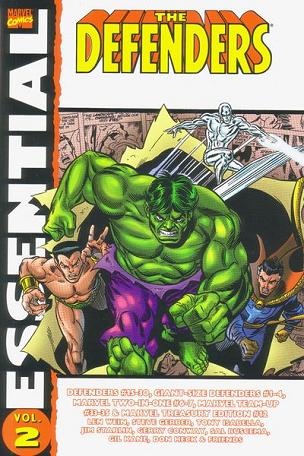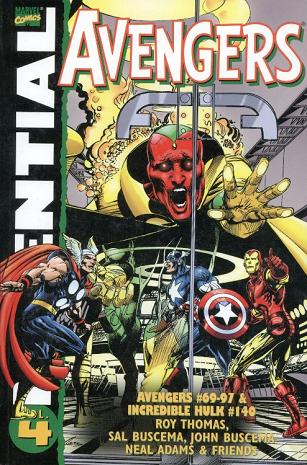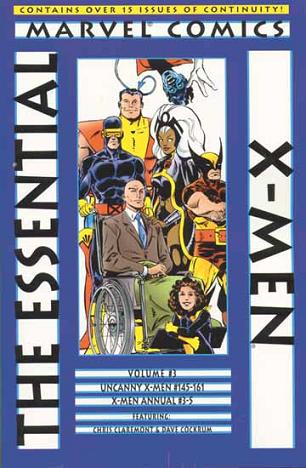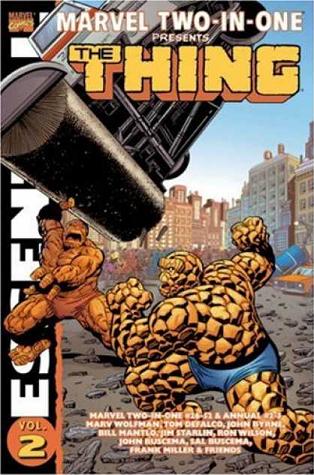
Essential Defenders Vol. 02
Steve Gerber, Sal Buscema and friends
Reprints: Defenders #15-30, Giant-Size Defenders #1-5 and much more (July 1974 – December 1975)
Get this for: Gerber and Marvel’s only non-team team — four stars
The Defenders is one of the …odder… ideas for a title Marvel ever had. Take four heroes never known for being easy to work with, with nothing in common and make them into a “non-team”. Sure, the Silver Surfer, Hulk, Doctor Strange and Namor the Submariner all are “big guns”, but putting them together in one series, especially the Hulk? Hadn’t Marvel learned that lesson with The Avengers? And yet… It worked sort of, worked enough to get them their own series after a trial out in Marvel Feature but at least to me it never really gelled until a certain Steve Gerber joined the title…
Essential Defenders Vol. 2 contains the first half of Gerber’s run on The Defenders, but it starts with Len Wein on writing duties. Wein treats the Defenders as a fairly standard superhero team, having them e.g. fight Magneto and the Wrecking Crew. Once Gerber takes over things get weirder, more offbeat, slightly more existentialist. By this time only the Hulk and Doctor Strange remained of the original team, with Valkyrie and Nighthawk as new members, plus various co-stars, including Yellowjacket, Daredevil, Luke Cage and the Son of Satan. That core group of the Hulk, Doctor Strange, Valkyrie and Nighthawk works well together, especially with the Hulk softened up a bit to make him more of a teamplayer.
Now The Defenders used to be my favourite Marvel team back when I first started to read superhero comics and the Gerber stories collected here were one of the reasons why. Two stories in particular stand out. The first is the Defenders clash with the Sons of the Serpents, Marvel’s go-to club of dimwitted but dangerous racist tools. Here once again the twist at the end of the story is that the guy using them is *gasp* Black and only using them for their own personal gains, as it was more or less in their earlier Avengers appearances. What Gerber does differently is to pay more attention to the damage done by the Serpents, has more of an eye for the reality of America in the Seventies than earlier writers using the Serpents had.
The other story is the Guardians of the Galaxy story that ran from Giant-Size Defenders #5 to Defenders #29, which turned me into a fan of them as well. Especially interesting there is issue 26, which has a recap of how the far future of the Guardians came into being, complete with trademark Gerber social commentary — “we valued dry armpits and the three billion dollar aerosol industry over our flowers, our food and ultimately our health” — as the depletion of the ozone layer leads to the widespread use of bionics by the mid-eighties…. Gerber also manages to tie-in the old Killraven series into this future history by the way.
The volume ends with Gerber’s most famous creation, Howard the Duck teaming up with the Defenders in Marvel Treasury Edition #12, which I found to be a bit meh. Howard is an acquired taste and for the most part has aged badly, apart from in a few classic stories. He’s just too seventies. Gerber does much better with the Defender’s characters: more so than any other team you feel that the core members are friends just hanging out rather than coming together to fight crime, which I’ve always found appealing.
The art throughout the volume, with some exceptions including a great issue by Gil Kane, is by Sal Buscema, who is not at his best here. It’s serviceable, rather than good. His pedestrian art undermines some of the pizazz of Gerber’s writing; you’d want a more interesting artist to interpret his plots like on Man-Thing or Howard the Duck. On the other hand there is the fact that Sal Buscema’s style is easy to understand, clean and clear and for a somewhat more mainstream title like The Defenders this may be a more suitable style.
The best of Gerber’s Defenders is still to come and not in this volume, but it’s a great starting point for the series. Most of the bugs have been taken out of the series here and you get the start of what made The Defenders tick for so long.


